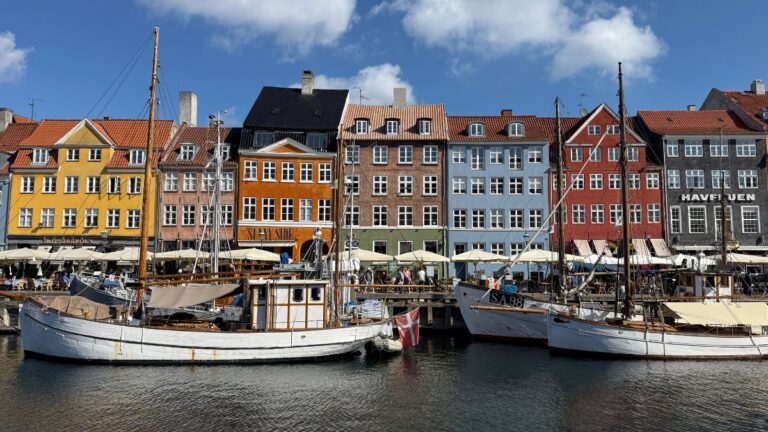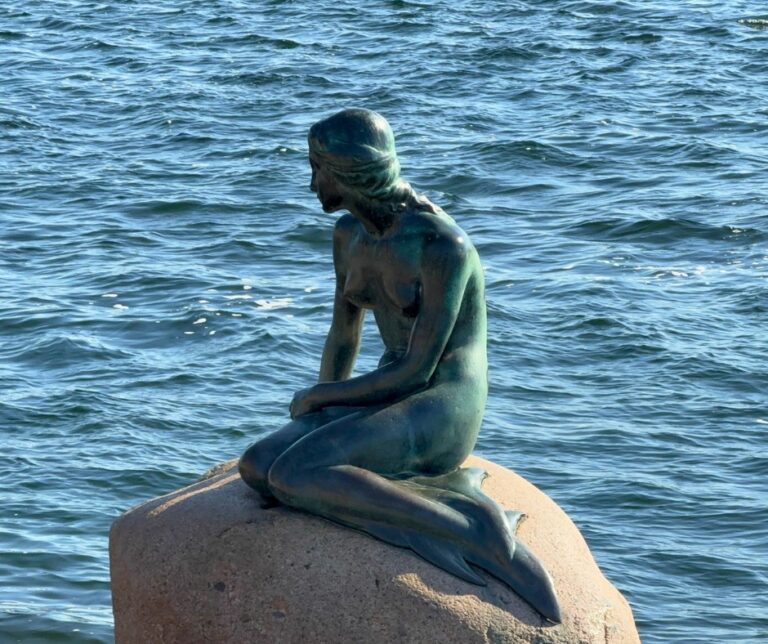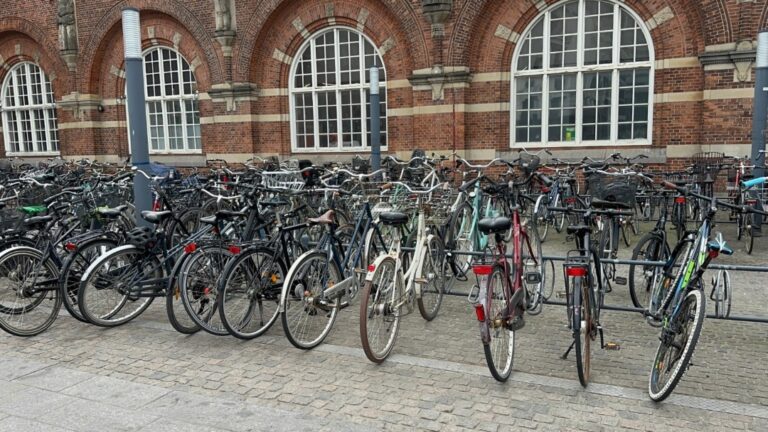Denmark’s capital city Copenhagen is a historic city packed with landmarks and modern attractions. Here are some fascinating facts you may or may not know about Copenhagen.
Continuing our journey around the Nordic region, it’s time to head south to our Danish neighbours. Copenhagen is one of those cities that feels both familiar and surprising.

For Norwegians, it’s an easy weekend break, just a short flight or ferry away. For international travellers, it often serves as the gateway to Scandinavia.
But how much do you really know about the Danish capital? Behind the bike lanes, castles, and fairytale statues lies a city with a long and complex history.
Whether you’re planning a stop on a wider Scandinavian itinerary, or you just want to add to your store of Nordic knowledge, here are ten fascinating facts about Copenhagen.
1. Copenhagen Was Once the Capital of Norway
Today, Copenhagen is firmly the capital of Denmark, but for centuries it also held sway over Norway. In fact, the city acted as Norway’s effective capital not once but twice, during two very different political unions.
Copenhagen Travel Resources: Planning a trip to Denmark? Check out this list of things to do in Copenhagen
The first was the Kalmar Union, which bound Denmark, Norway, and Sweden together under a single monarch from 1397 until 1523.
Although technically all three kingdoms retained their own laws and customs, Copenhagen became the de facto centre of power. It was here that decisions were made about trade, taxation, and foreign policy, and those decisions rippled across Norway.
The union was created partly to resist the growing might of the Hanseatic League, a powerful network of merchant cities that dominated trade around the Baltic and North Seas.
Centuries later, another arrangement tied Norway even more tightly to Copenhagen. From 1536 to 1814, Denmark and Norway were ruled together as a dual kingdom, with Copenhagen as the political and cultural heart.

Norway had no separate institutions of government; everything from royal decrees to tax collection was directed from the Danish capital.
The consequences were far-reaching. Danish became the language of administration and literature in Norway, and many elements of Danish culture blended into Norwegian society. Even after the union ended in 1814, Danish influence remained woven into Norway’s language, traditions, and institutions.
To this day, the shared history between the two nations is visible in everything from their similar written languages to their intertwined royal families.
2. Copenhagen Began as a Viking Age Fishing Village
Copenhagen may be a bustling modern capital today, but its origins were far more modest. The city traces its beginnings to the early 11th century, when a small fishing settlement grew up along the sheltered shores of the Øresund Strait.
The strait itself was crucial: narrow, easily navigable, and rich in fish, it provided both food and a natural highway for trade.
Archaeological evidence shows that people had lived in the area for thousands of years, but it was during the Viking Age that a more permanent community took shape. The name “København” itself reflects these roots, meaning “merchants’ harbour.”
It was not a grand city at first. more likely a cluster of wooden houses, simple jetties, and boats pulled up on the beach.
What set the settlement apart was its location. The Øresund was the gateway between the North Sea and the Baltic Sea, and anyone wishing to pass between them had little choice but to sail past Copenhagen.
This gave the villagers an advantage, as they could trade fish and agricultural products with passing merchants. Over time, tolls and duties were introduced on shipping traffic, boosting the settlement’s importance even further.
From these humble beginnings, Copenhagen steadily grew in wealth and stature. By the late Middle Ages, it had developed into a thriving town, protected by fortifications and supported by royal favour.
3. Tivoli Gardens is a Historic Amusement Park
Few attractions in Europe blend history and entertainment quite like Tivoli Gardens. Opened in 1843, the park is one of the world’s oldest operating amusement parks, and for generations it has been the beating heart of leisure in Copenhagen.

Yet Tivoli is more than rollercoasters and candyfloss. It’s an institution, one that reflects Danish culture as much as it entertains.
The park was the brainchild of Georg Carstensen, who convinced King Christian VIII that “when the people are amusing themselves, they do not think about politics.” The king granted him land just outside the city walls, and Tivoli was born.
From the very beginning, it was designed to be a place of wonder: manicured gardens, exotic pavilions, orchestral music, and thrilling rides all combined to create a world apart from the streets outside.
Over the decades, Tivoli has evolved while carefully preserving its fairy-tale atmosphere. Wooden rollercoasters dating back to 1914 stand alongside sleek, modern rides.
Summer evenings bring concerts, ballet, and open-air theatre, while the autumn and winter months see the park transformed with Halloween decorations and Christmas markets. Visitors young and old return year after year, drawn by the park’s unique blend of nostalgia and novelty.
Tivoli’s influence has reached far beyond Denmark. Walt Disney himself visited in the 1950s and took inspiration from its layout and ambience when creating Disneyland.
Today, more than four million people pass through its gates each year, making Tivoli one of Denmark’s most popular attractions and an enduring symbol of Copenhagen’s charm.
4. A Fairytale at the Heart of Copenhagen
For many visitors, no trip to Copenhagen feels complete without a stop at the bronze statue of the Little Mermaid.

Perched quietly on a rock at the edge of the harbour, she is far smaller than first-timers expect, yet she has become one of the most photographed sights in all of Denmark.
The statue was commissioned in 1909 by brewer Carl Jacobsen, heir to the Carlsberg fortune, after he attended a ballet performance based on Hans Christian Andersen’s fairy tale. Enchanted by the story, he asked sculptor Edvard Eriksen to create a permanent tribute.
Eriksen’s wife served as the model for the figure’s face, while the body was modelled on a professional ballerina.
Unveiled in 1913, the statue quickly became a beloved emblem of the city. But her fame has also made her a frequent target. Over the decades, she has been vandalised, decapitated, and even blown off her rock, only to be carefully restored each time.
These incidents have paradoxically strengthened her status, as locals and visitors alike rally to protect their mermaid.
5. Copenhagen Is a Bike-Friendly City
If there is one thing that defines daily life in Copenhagen, it is the bicycle. More than just a way to get around, cycling is part of the city’s identity. Around 40% of residents commute to work or school by bike, a figure that leaves most other European capitals far behind.
The city has invested heavily in infrastructure to make this possible. Wide, dedicated bike lanes crisscross the city, often separated from car traffic, and new bridges have been built exclusively for cyclists and pedestrians.
One of the most striking is the Cykelslangen, or “Bicycle Snake,” a raised orange cycleway that winds above the harbour, offering commuters both convenience and a bit of fun.
For visitors, cycling is often the easiest way to experience the city at street level. Bike rental shops are everywhere, and Copenhagen even has its own system of public bikes fitted with GPS tablets.
Pedalling through neighbourhoods like Nørrebro or along the waterfront gives a glimpse of everyday life that is hard to capture from behind the window of a bus.

Copenhagen’s commitment to cycling is about both lifestyle and sustainability. By encouraging bikes over cars, the city has cut congestion and pollution, while promoting healthier habits among its residents.
The result is a capital that feels more relaxed and human in scale, even as it continues to grow.
6. Christiania Has a Spirit All Its Own
Few places in Copenhagen spark as much curiosity as Freetown Christiania. Established in 1971, when a group of squatters took over an abandoned military barracks, the area declared itself a self-governing community, separate from the Danish state.
Over fifty years later, it still exists in a curious balance between alternative ideals and mainstream tourism.
Christiania is home to around 1,000 residents who share responsibility for running the community. Decisions are made collectively, often at meetings where every voice has the chance to be heard.
Over the years, residents have built colourful homes, art installations, cafés, and workshops, creating an atmosphere that feels more like a village than part of a capital city.
For much of its history, Christiania was controversial. Its open cannabis trade put it at odds with Danish authorities, leading to repeated police interventions and national debate. Today, the trade has been curtailed, but the neighbourhood still carries the reputation of being a place where rules are bent and counterculture thrives.
Tourists flock to Christiania not just for its reputation but also for its creative spirit. Murals cover walls, music venues buzz late into the night, and hand-built houses stand as a testament to the community’s do-it-yourself ethos.
7. Copenhagen Is a Gastronomic Powerhouse
Copenhagen’s food scene is nothing short of world-class, and the city’s Michelin stars prove it. In 2025, the Danish capital was home to 19 Michelin-starred restaurants with a total of 30 stars, more than any other city in the Nordics.
At the very top of the list sit Geranium, Jordnær, and the legendary Noma, each holding three stars. They are joined by acclaimed two-starred venues such as AOC, Kadeau, Alchemist, Kong Hans, and Koan, while a long list of one-starred restaurants ensures that fine dining in Copenhagen is never far away.
Noma, in particular, has become a global name. Famous for pioneering “New Nordic” cuisine under chef René Redzepi, it has repeatedly been crowned the best restaurant in the world.
While it announced plans to eventually transition into a food innovation lab, Noma continues to welcome diners for seasonal menus, and demand for reservations remains fierce.
This extraordinary concentration of talent has made Copenhagen a destination in its own right for food lovers. Visitors come not just to eat, but to experience a culinary culture that values creativity, local ingredients, and a constant willingness to reinvent what fine dining can be.
8. Copenhagen is renowned for its castles
For a capital of its size, Copenhagen boasts an impressive number of royal residences and historic castles, each with its own story to tell. These buildings are not only striking landmarks but also reminders of Denmark’s long monarchical tradition.

For a capital of its size, Copenhagen boasts an impressive number of royal residences and historic castles, each with its own story to tell. These buildings are not only striking landmarks but also reminders of Denmark’s long monarchical tradition.
At the heart of the city stands Amalienborg Palace, home to the Danish royal family. The palace consists of four elegant Rococo mansions arranged around an open square. Every day at noon, visitors gather to watch the ceremonial changing of the guard, a tradition that has become one of Copenhagen’s most recognisable sights.
Nearby lies Rosenborg Castle, a smaller but no less fascinating residence. Built in the early 17th century by King Christian IV, it houses the Danish crown jewels and regalia, displayed in opulent chambers that transport visitors back to the Renaissance.
The castle’s gardens, the King’s Garden, are among the city’s most popular green spaces, particularly in summer when Copenhageners flock there for picnics.
Just beyond the city centre stands Christiansborg Palace, a working building that houses the Danish Parliament, Supreme Court, and Prime Minister’s Office.
Parts of the palace are still used by the royal family for official functions, making it one of the few sites in the world where all three branches of government share the same roof.
9. The Round Tower Offers a Unique Vantage Point
Among Copenhagen’s many historic buildings, few are as distinctive as the Round Tower.
Built in the 17th century under King Christian IV, it was designed as an astronomical observatory and is still used for stargazing today, making it the oldest functioning observatory in Europe.
What makes the tower truly unusual is its interior. Instead of stairs, visitors ascend via a wide, gently spiralling ramp that winds its way up to the viewing platform.
The design allowed horses and carts to haul heavy astronomical equipment to the top, and it now provides a surprisingly easy climb for modern visitors. Along the way, small exhibition rooms host cultural displays, adding to the experience.
Once at the top, the reward is a panoramic view across Copenhagen’s rooftops. The spires of churches, the domes of palaces, and the sweep of the harbour are all visible, offering one of the best vantage points in the city.
On clear evenings, astronomers still invite the public to peer through the telescope, continuing the tower’s original purpose more than 350 years after it was built.
The Round Tower is more than just an architectural curiosity. It reflects Denmark’s long tradition of scientific enquiry and the ambitions of a king who wanted his capital to stand at the forefront of knowledge.
10. Copenhagen Airport Is Scandinavia’s Main Gateway
For many travellers, the first encounter with Copenhagen comes not in the city itself but at Copenhagen Airport. Known locally as Kastrup, it is the largest and busiest airport in the Nordic region, handling tens of millions of passengers each year.
Copenhagen Travel Resources: Planning a trip to Denmark? Check out this list of things to do in Copenhagen
The airport’s success lies in its location. Sitting at the narrow Øresund Strait, it is perfectly placed to serve not only Denmark but also southern Sweden, with Malmö just a short train ride away via the Øresund Bridge. This has made it a true regional hub, connecting Scandinavia with Europe, Asia, and North America.
Copenhagen Airport is also a base for Scandinavian Airlines (SAS), which uses it as its main intercontinental hub. From here, travellers can fly direct to cities as far afield as Tokyo, New York, and Bangkok, as well as to almost every European capital.
Beyond its sheer size, the airport is known for its efficiency and design. Terminals are sleek and easy to navigate, with touches of Danish style that make the journey more pleasant than stressful.
For many, arriving at Kastrup sets the tone for a Scandinavian trip: practical, well-organised, and quietly stylish.
From Viking roots to royal castles, cutting-edge cuisine, and a cycling culture admired around the world, Copenhagen is a city that never stops surprising those who take the time to explore it.

